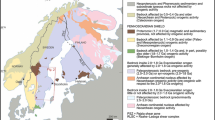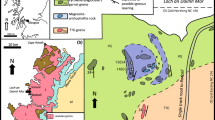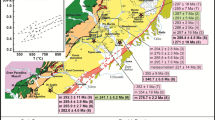Abstract
U-Pb zircon data from selected gneiss samples provide estimates of the timing of igneous protolith emplacement and granulite facies metamorphism in the Gruinard Bay, Badcall Bay and Lochinver areas of the mainland Lewisian Gneiss Complex of north-west Scotland. Zircons from the gneisses contain complex zoning patterns making them amenable to SHRIMP ion microprobe analysis, with inherited zircon distinguishable from magmatic growth and metamorphic recrystallisation. From Gruinard Bay, a tonalitic granulite yielded a protolith age of 2,825±8 Ma for oscillatory-zoned zircon cores, with recrystallised low-U rims preserving an age of 2,733±12 Ma. An inherited 2,905±15 Ma age component was recognised in a sample of trondhjemitic gneiss, the protolith of which is estimated to have been emplaced at 2,858±11 Ma. Low-U rims yielding an age of 2,729±20 Ma are also present, which together with the rim age from the granulite are considered to date granulite facies metamorphism in the Gruinard region. For comparison with the Gruinard Bay gneisses, a trondhjemitic partial melt and trondhjemite sheet were analysed from the granulite facies rocks at Badcall Bay in the Assynt terrane. Age data do not show definitive relationships with zoning patterns in the zircons, and show a spread along concordia typical of previous ion microprobe age data from the Scourie gneisses. Both samples do, however, show a significant isotopic disturbance at 2,480 Ma, the most recent estimate for the Badcallian metamorphism. Protolith ages for components of the Assynt terrane range between ca. 2,900 and 3,030 Ma, and appear to be older than the 2,860–2,825 Ma gneiss protoliths from the Gruinard Bay area. The timing of granulite facies metamorphism also appears to be different between the two areas, suggesting that the two granulite regions of the mainland may not be related as previously thought. Instead, they are interpreted in terms of a terrane accretion model whereby the two areas evolved as separate blocks prior to their juxtaposition during the Palaeoproterozoic. The boundary between the two terranes is thought to lie to the south of Lochinver, corresponding with the Strathan Line, because of the observed 2,480 Ma age signature to the north and 2,730 Ma signature to the south. By defining a new mainland terrane, the Gruinard Terrane, the number of mainland blocks, which includes the Assynt (central), Rhiconich (northern) and Southern terranes, has been expanded.






Similar content being viewed by others
References
Attfield P (1987) The structural history of the Canisp Shear Zone. Geol Soc Lond Spec Publ 27:165–173
Beach A, Coward MP, Graham RH (1974) An interpretation of the structural evolution of the Laxford Front, Northwest Scotland. Scott J Geol 9:297–308
Bowes DR, Wright AR, Park RG (1964) Layered intrusive rocks in the Lewisian of the NW Highlands of Scotland. J Geol Soc Lond 120:153–191
Bowes DR (1969) The Lewisian of Northwest Highlands of Scotland. In: Kay M (ed) North Atlantic geology and continental drift—a symposium. Am Assoc Petrol Geol, pp 575–594
Cartwright I (1988) Crystallization of melts, pegmatite intrusion and the Inverian retrogression of the Scourian complex, north-west Scotland. J Metamorph Geol 6:77–93
Cartwright I (1990) Prograde metamorphism, anatexis and retrogression of the Scourian complex, north-west Scotland. In: Ashworth JR, Brown M (eds) High-temperature metamorphism and crustal anatexis. Unwin-Hyman, London, pp 371–399
Cartwright I, Barnicoat AC (1987) Petrology and petrogenesis of Scourian supracrustals and orthogneisses from the Lewisian at Stoer, NW Scotland, and their bearing on geological evolution of the Lewisian Complex. In: Park RG, Tarney J (eds) Evolution of the Lewisian and comparable high-grade terranes. Geol Soc Spec Publ 27:93–108
Chapman HJ, Moorbath S (1977) Lead isotope measurements from the oldest recognised Lewisian gneisses of north-west Scotland. Nature 268:41–42
Compston W, Williams IS, Meyer C (1984) U-Pb geochronology of zircons from lunar breccia 73217 using a sensitive high mass-resolution ion microprobe. Proc 14th Lunar Planet Conf. J Geophys Res 89 Suppl B525-B534
Corfu F, Crane A, Moser D, Rogers G (1998) U-Pb zircon systematics at Gruinard Bay, northwest Scotland: implications for the early orogenic evolution of the Lewisian Complex. Contrib Mineral Petrol 133:329–345
Corfu F, Heaman LM, Rogers G (1994) Polymetamorphic evolution of the Lewisian complex, NW Scotland, as recorded by U-Pb isotopic compositions of zircon, titanite and rutile. Contrib Mineral Petrol 117:215–228
Crane A (1978) Correlation of metamorphic fabrics and the age of Lewisian metasediments near Loch Maree. Scott J Geol 14:225–246
Davies FB (1975) Origin and ancient history of gneisses older than 2,800 myr in the Lewisian Complex. Nature 258:589–591
Davies FB (1976) Early Scourian structures in the Scourie-Laxford region and their bearing on the evolution of the Laxford Front. J Geol Soc Lond 132:543–554
Evans CR (1963) The geology of the Lochinver district. Unpub. PhD Thesis, Oxford University
Evans CR (1965) Geochronology of the basement near Lochinver, Sutherland. Nature 207:54–56
Evans CR, Tarney J (1964) Isotopic ages of Assynt dykes. Nature 204:638–641
Evans CR, Lambert RSJ (1974) The Lewisian of Lochinver, Sutherland; the type area for the Inverian metamorphism. J Geol Soc Lond 130:125–150
Field D (1978) Granulites at Gruinard Bay. Scott J Geol 14:359–361
Fowler MB (1986) Large-ion lithophile element characteristics of an amphibolite to granulite facies transition at Gruinard Bay, north-west Scotland. J Metamorph Geol 4:345–349
Fowler MB, Plant JA (1987) Rare earth element geochemistry of Lewisian grey gneisses from Gruinard Bay. Scott J Geol 23:193–202
Friend CRL, Kinny PD (1995) New evidence for protolith ages of Lewisian granulites, northwest Scotland. Geology 23:1027–1030
Friend CRL, Kinny PD (2001) A reappraisal of the Lewisian Gneiss Complex: geochronological evidence for its tectonic assembly from disparate terranes in the Proterozoic. Contrib Mineral Petrol 142:198–218
Giletti BJ, Moorbath S, Lambert RSJ (1961) A geochronological study of the metamorphic complexes of the Scottish highlands. Q J Geol Soc Lond 117:233–272
Hamilton PJ, Evenson NM, O’Nions RK, Tarney J (1979) Sm-Nd systematics of Lewisian gneisses: implications for the origin of granulites. Nature 277:25–28
Heaman LM, Tarney J (1989) U-Pb baddeleyite ages for the Scourie dyke swarm, Scotland: evidence for two distinct intrusion events. Nature 340:705–708
Hoskin PWO, Black LP (2000) Metamorphic zircon formation by solid-state recrystallization of protolith igneous zircon. J Petrol 18:423–439
Humphries FJ, Cliff RA (1982) Sm-Nd dating and cooling history of Scourian granulites, Sutherland. Nature 295:515–517
Kinny PD, Friend CRL (1997) U-Pb isotopic evidence for the accretion of different crustal blocks to form the Lewisian Complex of northwest Scotland. Contrib Mineral Petrol 129:326–340
Khoury SG (1968) The structural geometry and geological history of the Lewisian rocks between Kylesku and Geisgeil, Sutherland, Scotland. Krystalinikum 6:41–78
Lambert RSJ, Holland JG (1972) A geochronological study of the Lewisian from Loch Laxford to Durness, Sutherland, NW Scotland. J Geol Soc Lond 128:3–19
Moorbath S, Welke H, Gale NH (1969) The significance of Pb isotope studies in ancient, high-grade metamorphic basement complexes, as exemplified by the Lewisian rocks of northwest Scotland. Earth Planet Sci Lett 6:245–256
Moorbath S, Park RG (1971) The Lewisian chronology of the southern region of the Scottish mainland. Scott J Geol 8:51–74
O’Hara MJ (1977) Thermal history of excavation of Archaean gneisses from the base of the continental crust. J Geol Soc Lond 134:185–200
Park RG (1969) The structural evolution of the Tollie antiform—a geometrically complex fold in the Lewisian north-east of Gairloch, Ross-shire. Q J Geol Soc Lond 125:319–349
Park RG (1970) Observations on Lewisian chronology. Scott J Geol 6:379–399
Park RG, Tarney J (1987) The Lewisian complex: a typical Precambrian high-grade terrain? In: Park RG, Tarney J (eds) Evolution of the Lewisian and comparable Precambrian high-grade terrains. Geol Soc Spec Publ 27:13–25
Park RG, Tarney J, Connelly JN (2001) The Loch Maree Group: Palaeoproterozoic subduction-accretion complex in the Lewisian of NW Scotland. Precambrian Res 105:205–226
Park RG, Crane A, Niamatullah M (1987) Early Proterozoic structure and kinematic evolution of the southern mainland Lewisian. In: Park RG, Tarney J (eds) Evolution of the Lewisian and comparable Precambrian high-grade terrains. Geol Soc Spec Publ 27:139–151
Park RG, Cliff RA, Fettes DJ, Stewart AD (1994) Precambrian rocks in northwest Scotland west of the Moine Thrust: the Lewisian Complex and the Torridonian. In: Gibbons W, Harris AL (eds) A revised correlation of Precambrian rocks in the British Isles. Geol Soc Spec Rep 22:6–22
Peach BN, Horne J, Gunn W, Clough CT, Hinxman LW, Teall JJH (1907) The geological structure of the North West Highlands of Scotland. Mem Geol Surv UK
Pidgeon RT (1992) Recrystallisation of oscillatory zoned zircon: some geochronological and petrological implications. Contrib Mineral Petrol 110:463–472
Pidgeon RT, Bowes DR (1972) Zircon U-Pb ages of granulites from the Central Region of the Lewisian, northwestern Scotland. Geol Mag 109:247–258
Pride C, Muecke GK (1980) Rare earth element geochemistry of the Scourian complex N.W. Scotland—evidence for the granite-granulite link. Contrib Mineral Petrol 73:403–412
Pride C, Muecke GK (1982) Geochemistry and origin of granitic rocks, Scourian complex, NW Scotland. Contrib Mineral Petrol 80:379–385
Rollinson HR (1996) Tonalite-trondhjemite-granodiorite magmatism and the genesis of Lewisian crust during the Archaean. In: Brewer TS (ed) Precambrian crustal evolution of the North Atlantic Region. Geol Soc Spec Publ, pp 25–42
Rollinson HR, Fowler MB (1987) The magmatic evolution of the Scourian Complex at Gruinard Bay. In: Park RG, Tarney J (eds) Evolution of the Lewisian and comparable Precambrian high-grade terrains. Geol Soc Spec Publ 27:57–71
Rollinson HR, Windley BF (1980a) An Archaean granulite-grade tonalite-trondhjemite-granite suite from Scourie, NW Scotland: geochemistry and origin. Contrib Mineral Petrol 72:265–281
Rollinson HR, Windley BF (1980b) Selective elemental depletion during metamorphism of Archaean granulites, Scourie, NW Scotland. Contrib Mineral Petrol 72:257–263
Savage D, Sills JD (1980) High pressure metamorphism in the Scourian of NW Scotland: evidence from garnet granulites. Contrib Mineral Petrol 74:153–163
Schaltegger U, Fanning CM, Gunther D, Maurin JC, Schulmann K, Gebauer D (1999) Growth, annealing and recrystallisation of zircon and preservation of monazite in high-grade metamorphism: conventional and in-situ U-Pb isotope, cathodoluminescence and microchemical evidence. Contrib Mineral Petrol 143:186–201
Sheraton JW, Skinner AC, Tarney J (1973) The geochemistry of the Scourian gneisses of the Assynt district. In: Park RG, Tarney J (eds) The Early Precambrian of Scotland and related rocks of Greenland. University of Keele, pp 13–30
Sills JD, Rollinson HR (1987) Metamorphic evolution of the mainland Lewisian complex. In: Park RG, Tarney J (eds) Evolution of the Lewisian and comparable Precambrian high-grade terrains. Geol Soc Spec Publ 27:81–92
Sommerauer J (1974) Trace element distribution patterns and the mineralogical stability of zircon—an application for combined electron microprobe techniques. Electron Microscopy Soc S Afr Proc 4:71–72
Steiger RH, Jäger E (1977) Subcommission on geochronology: convention on the use of decay constants in geo- and cosmochronology. Earth Planet Sci Lett 36:359–362
Sutton J, Watson J (1951) The pre-Torridonian metamorphic history of the Loch Torridon and Scourie areas in the North-West Highlands and its bearing on the chronological classification of the Lewisian. Q J Geol Soc Lond 106:241–307
Tarney J (1963) Assynt dykes and their metamorphism. Nature 199:672–674
Vavra G (1994) Systematics of internal zircon morphology in major Variscan granitoid types. Contrib Mineral Petrol 117:331–344
Vavra G, Gebauer D, Schmidt R, Compston W (1996) Multiple zircon growth and recrystallisation during polyphase Late Carboniferous to Triassic metamorphism in granulites of the Ivrea Zone (Southern Alps): an ion-microprobe (SHRIMP) study. Contrib Mineral Petrol 122:337–358
Weaver BL, Tarney J (1980) Rare earth geochemistry of Lewisian granulite facies gneisses, NW Scotland: implications for the peterogenesis of the Archaean lower crust. Earth Planet Sci Lett 51:279–296
Weaver BL, Tarney J (1983) Elemental depletion in Archaean granulite-facies rocks. In: Atherton MP, Gribble CD (eds) Migmatites, melting and metamorphism. Shiva Publishing, Orpington, pp 250–263
Whitehouse MJ (1988) Granulite facies Nd-isotopic homogenization in the Lewisian complex of northwest Scotland. Nature 331:705–707
Whitehouse MJ (1989a) Pb-isotopic evidence for U-Th-Pb behaviour in a prograde amphibolite to granulite facies transition from the Lewisian complex of north-west Scotland: Implications for Pb-Pb dating. Geochim Cosmochim Acta 53:717–724
Whitehouse MJ (1989b) Sm-Nd evidence for diachronous crustal accretion in the Lewisian complex of northwest Scotland. Tectonophysics 161:245–256
Whitehouse MJ, Claesson S, Sunde T, Vestin J (1997) Ion microprobe U-Pb zircon geochronology and correlation of Archaean gneisses from the Lewisian Complex of Gruinard Bay, northwestern Scotland. Geochim Cosmochim Acta 61:4429–4438
Whitehouse MJ, Fowler MB, Friend CRL (1996). Conflicting mineral and whole-rock isochron ages from the Late-Archaean Lewisian Complex of northwestern Scotland: implications for geochronology in polymetamorphic high-grade terrains. Geochim Cosmochim Acta 60:3085–3102
Zhu XK, O’Nions RK, Belshaw NS, Gibb AJ (1997a) Lewisian crustal history from in situ SIMS mineral chronometry and related metamorphic textures. Chem Geol 136:205–218
Zhu XK, O’Nions RK, Gibb AJ (1997b) Significance of in situ SIMS chronometry of zoned monazite from the Lewisian granulites, northwest Scotland. Chem Geol 135:35–53
Acknowledgements
Research was carried out while GJL was in receipt of a Curtin University Postgraduate Scholarship, which is gratefully acknowledged. Funding for analytical work was courtesy of a Curtin University small grant (PK) with travel assistance for fieldwork from a Tectonics Special Research Centre travel grant. U-Pb zircon analyses were performed on the sensitive high-resolution ion microprobe (SHRIMP II) located at the John de Laeter Centre for Mass Spectrometry at Curtin University, which is operated by a consortium consisting of Curtin University of Technology, the University of Western Australia and the Geological Survey of Western Australia, with support from the Australian Research Council. C.R.L.F. acknowledges financial support from Oxford Brookes University towards costs of the field and probe work. Constructive reviews by A. Crane and S. Harley were much appreciated. This is TSRC publication number 219.
Author information
Authors and Affiliations
Corresponding author
Additional information
Editorial responsibility: I. Parsons
Rights and permissions
About this article
Cite this article
Love, G.J., Kinny, P.D. & Friend, C.R.L. Timing of magmatism and metamorphism in the Gruinard Bay area of the Lewisian Gneiss Complex: comparisons with the Assynt Terrane and implications for terrane accretion. Contrib Mineral Petrol 146, 620–636 (2004). https://doi.org/10.1007/s00410-003-0519-1
Received:
Accepted:
Published:
Issue Date:
DOI: https://doi.org/10.1007/s00410-003-0519-1




